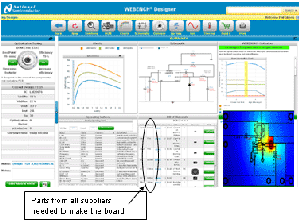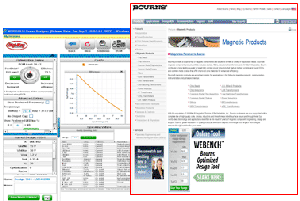How Custom Product Design Can Spawn Customer-Centric Ecosystems
How National Semiconductor, CustoMax, and Zazzle Built Vibrant Ecosystems
The most successful businesses have managed to attract and grow vibrant ecosystems of suppliers and partners. When those ecosystems are customer-centric, they attract and retain customers, who, in turn, attract more customers. Customer-centric ecosystems are designed to address a critical customer scenario. One of the most compelling scenarios is, “I want to custom design my own product.” We look at CustoMax (fashion apparel), National Semiconductor (analog computer chips), and Zazzle (quick turnaround custom retail merchandise). We describe the best practices each company used to spawn a customer-centric ecosystem around custom product development.
NETTING IT OUT
Why Are Customer-Centric Ecosystems Important to Customers?
Customers love it when they find a Web site or a supplier that anticipates their needs and gives them useful tools, resources, and information to accomplish the thing(s) they need to get done. If the customer can accomplish his or her entire scenario working with a single trusted brand, he’s usually happy to do so, but often prefers to be able to avail himself of resources from multiple, competing suppliers. Customers prefer an end-to-end solution, but they don’t like being locked in to a single provider. A customer-centric ecosystem featuring offerings from multiple suppliers is more trustworthy.
National Semiconductor’s Ecosystem Starts with the WEBENCH® Design Tools
Design, Simulate, Test, & Order Parts
© 2010 National Semiconductor, Inc.
National Semiconductor’s WEBENCH® Tools are available for a variety of circuit designs. In this case, the designer has selected the parts he wants for a power supply. Each panel on the dashboard can be interactively modified to change the design. In the middle of the bottom row is the current bill of materials with parts availability and pricing from multiple suppliers. At the far right is a thermal simulation.
WEBENCH Embedded
© 2010 National Semiconductor, Inc.
Distributors and OEMs Embed National Semiconductor’s WEBENCH into their Web Sites and Online Catalogs. Digikey was the first of National Semiconductor’s Distributors to feature the full WEBENCH toolkit on its site. Bourns was the first OEM supplier to include a private-labeled version of WEBENCH.
Why Are Customer-Centric Ecosystems Important to Your Company?
A vibrant customer-centric ecosystem is a huge competitive advantage! If your brand is the one-stop that customers prefer to use to accomplish the things they need to get done, you gain their loyalty and their business. By opening your solution to include competing and complementary products and services, you provide more complete and trusted solutions to customers, and your ecosystem grows organically.
Why Does Custom Product Design Spawn Customer-Centric Ecosystems?
Customers’ own design scenarios provide a magnet for attracting relevant suppliers.
WHY CREATE A CUSTOMER-CENTRIC ECOSYSTEM?
What if you could solve a customer-critical problem so well that you could grow a vibrant, profitable business that attracts more and more customers? That’s what every business wants to do, isn’t it?
What if you could expand the reach, scope, and profitability of that business by attracting more and more suppliers, resellers, and partners so that your business grows organically as the entire ecosystem grows?
New Business Pattern with Big Payoff
Everyone makes money. Partners and suppliers extend your reach. More and more customers are attracted, and they are all well-served. You gain an incredible competitive advantage by being able to provide total solutions to customers and by addressing a critical need they have. This is what happens when you succeed in creating a vibrant and sustainable customer-centric ecosystem.
Start with a Customer Scenario
The most successful customer-centric ecosystems are designed around one or more Customer Scenarios—a set of activities a customer is happy to do to achieve a goal that he/she has. Planning a trip, moving a business, designing a product, diagnosing and fixing a problem, planning a celebration for a special occasion—these are all examples of Customer Scenarios. Each of these activities requires products, resources, and information from multiple suppliers and sources.
There are several different types of customer-centric ecosystems. One particularly intriguing and successful category is ecosystems that are created to support customers in creating customized products.
What’s a Customer-Centric Ecosystem?
A customer-centric ecosystem surrounds each customer with the information, activities, and resources he or she needs to reach his or her goal, from a variety of independent sources.
The customer’s goal might be accomplishing a successful business trip, mastering a new skill, designing a new product, diagnosing and curing a malady, having a great birthday party, or training for a marathon.
The resources may include subject matter experts, peers who are performing the same scenario, tools that are needed to do tasks, products and services customers may need to achieve their goals, and just-in-time information at each step of the way.
What makes it an ecosystem is the fact that it’s populated by multiple, often competing, parties who have in common a commitment to support their mutual customers in accomplishing their scenarios as pleasantly and as efficiently as possible.
As a customer, you notice that you are in the hands of a customer-centric ecosystem when you realize that you have easy one-stop access to everything you need—all the information, resources and activities you need to accomplish a particular scenario—from multiple suppliers, partners, experts, and peers.
As an organization, you’ve built a customer-centric ecosystem when you’ve created a profitable, growing, sustainable, win/win network of customers, partners, suppliers, and your own company’s stakeholders—all aligned to support the activities that customers want to do to reach their goals.
THREE ECOSYSTEMS FOR DESIGNING CUSTOM PRODUCTS
We’ve noticed that the more customers engage in the customization and/or design of products and services, the more loyal and enthusiastic they typically are about both the products and about the experience of creating the customized product.
There are several different situations that call for custom product design:
- It’s your job to design products.
- You customize a product so that it meets your needs better.
- You customize a product to add value to it.
Let’s look at an example of each one—where the Customer Scenario of “I want to design a custom product” has became the magnet for a robust multi-party ecosystem that is thriving and growing. We’ll describe:
- National Semiconductor’s ecosystem for engineers whose job it is to design products.
- The CustoMax ecosystem for producing made-to-order fashions with better fit and finish.
- Zazzle’s ecosystem for customers who want to design customized objects for themselves or for others.
Then, we’ll highlight the successful principles that these disparate ecosystems have in common.
NATIONAL SEMICONDUCTOR’S ECOSYSTEM FOR ENGINEERS WHO ARE DESIGNING ELECTRONIC PRODUCTS
Design Tools Are the Glue
National Semiconductor’s WEBENCH® family of tools constitutes the nexus of an ecosystem of over 21,000 National Semiconductor and non-National components available through distributors and OEMs from 120 different suppliers.
Target Customers
Engineers designing power management, cell phones, LED lighting systems, large screen displays, solar panel installations, sensors, and a host of other products that require analog electronic components can avail themselves of National’s free Web-based tools.
The Customer Scenario
The engineer’s goal is to design a winning product. Her design scenario includes the activities required to design, optimize, simulate, and test circuitry; specify a complete bill of materials; make trade-offs for costs and performance; and order the bill of materials in small quantities in order to build and test prototypes.
National Semiconductor’s free Web-based tools support engineers in performing each of these activities...
Sign in to download the full article
0 comments
Be the first one to comment.





